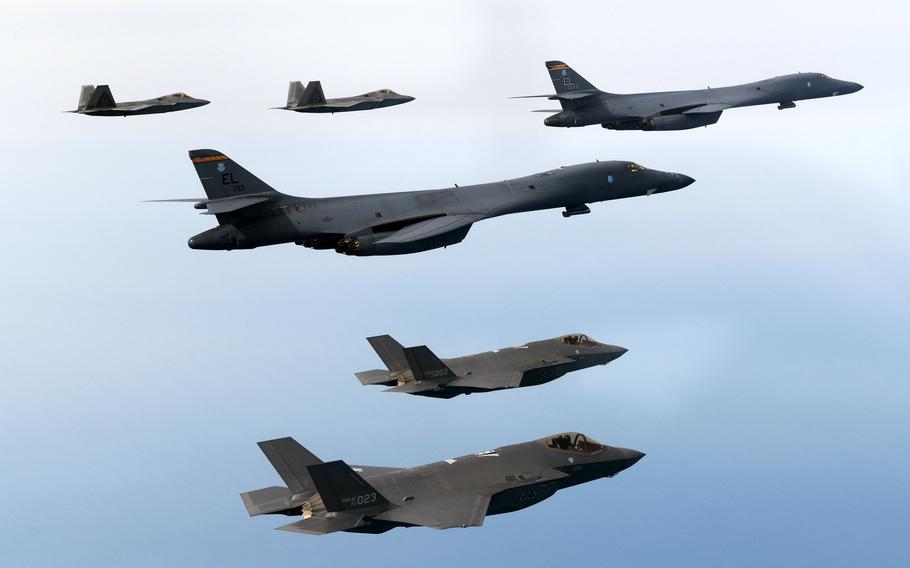
U.S. B-1B Lancer bombers, F-22 Raptors and F-35B Lightning II stealth fighters train with South Korean F-35As over the Yellow Sea, Wednesday, Feb. 1, 2023. (South Korea’s Ministry of National Defense)
CAMP HUMPHREYS, South Korea — The U.S. and South Korean air forces carried out their first air drill of the year, a day after defense chiefs from both countries agreed to increase joint training due to continued threats from North Korea.
South Korean F-35A Lightning II stealth fighters drilled Wednesday with U.S. F-35Bs, F-22 Raptors and B-1B Lancer bombers over the Yellow Sea, according to a Ministry of National Defense news release Thursday.
“The combined air drills held at this time show the U.S.’s will and ability to provide strong and reliable extended deterrence in preparation for North Korea’s nuclear and missile threat,” the release said.
The exercise was held one day after U.S. Defense Secretary Lloyd Austin and Defense Minister Lee Jong-sup met in Seoul. Austin, during a news briefing Wednesday, described his talks with Lee as “highly productive” and said the two agreed to continue military drills amid “North Korea’s unprecedented number of provocations.”
American bombers last flew with the South Korean fighters on Dec. 20, two days after North Korea fired a ballistic missile toward the East Sea, or Sea of Japan. U.S. B-52 Stratofortess bombers and F-22s flew with South Korean F-35s and F-15K Slam Eagles around South Korea’s airspace to bolster “capabilities to respond to North Korea’s nuclear and missile threats,” the defense ministry said in a news release at the time.
U.S. B-1B bombers also took part in a drill over South Korean airspace on Nov. 19, one day after North Korea fired a ballistic missile that dropped into Japan’s exclusive economic zone.
U.S. and South Korean officials said last year that North Korea had prepared to conduct its seventh nuclear test, its first since 2017. The communist regime fired about 75 missiles the same year, an annual record.
Large-scale military exercises that had been suspended or downscaled were restarted by Washington and Seoul last year in light of Pyongyang’s unprecedented activity.
The aircraft carrier USS Ronald Reagan sailed to Busan in September, its first such port call in five years.
One month later, roughly 240 U.S. and South Korean aircraft flew 1,600 sorties, the largest number ever, as part of the Vigilant Storm exercise in October.
The “political situation in the Korean Peninsula and the region has reached … a red line,” North Korea’s Foreign Ministry said in a statement published Thursday by the state-run Korean Central News Agency.
“The U.S. is going to ignite an all-out showdown with [North Korea] through continued combined drills whose scale and scope are largely extended,” the ministry said.
It added that North Korea is “not interested in any contact or dialogue with the U.S. as long as the latter persists in its hostile policy and confrontational line.”